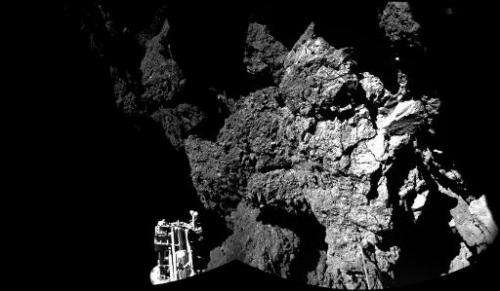Chilly Philae still slumbering, says comet mission

European space managers Friday ended an eight-day vigil for a wakeup call from the robot lander Philae, but remained hopeful the scout will revive as it rides on a comet nearing the Sun.
Monitoring for the lander, which has been hibernating since November, will resume next month, the mission said.
"Perhaps it is still too cold for the Philae lander to wake up on Comet 67P/Churyumov-Gerasimenko," the German Aerospace Centre (DLR) said in a blog posted by the European Space Agency (ESA).
"Maybe its power resources are not yet sufficient to send a signal to the team at the DLR Lander Control Center."
There has been no news of Philae for more than four months.
That was when the battery ran down on the 100-kilogram (220-pound) lab after it bumped down in a rugged, shadowed part of the comet.
Philae had just enough juice to carry out a 54-hour roster of core experiments before going into shutdown mode.
The hope is that as the comet races towards the Sun, more light will bathe the probe's solar panels, enabling it to power up again and resume work.
Its mother ship Rosetta sent down Philae on November 12 after a 10-year trek around the Solar System.
It began to listen out for signals on March 12 as it launched a schedule of orbital swoops around the spot where Philae is believed to have landed.
But there was only silence, and at 0400 GMT on Friday, Rosetta's communication unit was switched off, the ESA blog said.
"It was a very early attempt," said DLR Project Manager Stephan Ulamec.
"We will repeat this process until we receive a response from Philae. We have to be patient."
Engineers saw an early chance in March when comet and lander were about 300 million kilometers (187 million miles) from the Sun, and the amount of solar radiation had nearly doubled compared to November.
The next chance to receive a signal is during the first half of April, the blog said.
Philae needs an internal temperature of more than minus 45 degrees Celsius (minus 49 degrees Fahrenheit) and at least five watts of power to automatically turn on.
Until it can generate 19 watts, it cannot send signals to Earth via the orbiter.
Philae has 10 instruments, including a drill, chemistry sets and imaging tools.
It is the crowning feat in a 1.3-billion-euro ($1.4-billion) mission to unlock the secrets of comets, which some astrophysicists believe may have "seeded" Earth with some of the ingredients for life.
© 2015 AFP




















